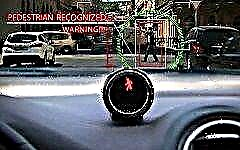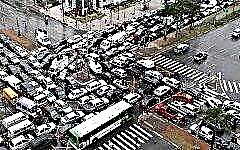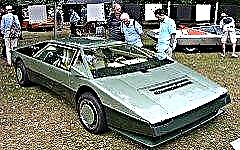

The content of the article:
- Brake system operation
- Ten important aspects of the braking system
- Brake pads
- Disks
- Leaks
- Seized brake pads
- Deformation of brake discs
- Decrease in braking efficiency
- Smoke pillar
- Brake indicator
- Brake hoses
- Parking brake
Are the brakes making strange noises? Are you hearing squeaks? Does the car "lead" to the side? Do smudges appear under the bottom? All this signals a brake system failure, which must be urgently eliminated in order to avoid danger to all road users.
Brake system operation

Currently, car brakes are made disc or drum. The first ones have in their design a brake disc attached to the wheel hub, a hydraulic system, pads, calipers that help stop or slow down the car.
When the driver steps on the pedal, the hydraulics apply reinforcement, forcing the pads to interact closely with the disc, causing a gradual deceleration and subsequent stop.
Drum brakes have a similar mechanism, only here, when working with the brake pedal, the hydraulics press the brake pads against the drum, providing braking.
Both are quite reliable, although due to their complex design and a large number of parts, they require careful maintenance and constant control over the operation process.
It should be recalled a few important nuances that all motorists should know about the braking system of their car.
Ten important aspects of the braking system
Brake pads

Pads are integral parts of the braking system that interact with the surface of the brake disc by pressing the brake pedal. Their design is as follows: a special overlay made of ceramics, rubber, synthetic materials or fibers is attached to a metal base.
Each manufacturer uses their own secret method of making pads, maintaining the main principle - maximum wear resistance. At the same time, they must withstand many thousands of mileage, but at the same time not harm the brake disc of the machine.
In addition, the pad materials must be resistant to extreme temperatures, especially the extremely high temperatures that occur during braking.
This pad is fixed to the brake plate with high-strength, heat-resistant glue or rivets. Depending on the type of brake system - drum or disc - the linings are made appropriately for better attachment.
The driver will have to carefully monitor the condition of the brake pads, since their wear not only serves as a source of extraneous sounds during braking, but also significantly increases the braking distance. With excessive overheating, which is often observed among fans of emergency braking, cracks form on the pads, emitting the same characteristic whistle or creak.
The front pads receive the main load, therefore, if squeaks occur, the inspection should begin with them. The car owner is not recommended to save on this spare part, since a bad friction layer on cheap options will wear off many times faster, shortening the life of the pads.
Disks

The brake disc is a key part of the brake system, which is a metal surface for the pad that rotates with the wheel at a similar speed. When the brake pedal is pressed, the disc contacts the pads, thereby slowing down the movement of the vehicle.
The surface of a good brake disc looks absolutely flat, only in this way it provides proper adhesion to the pads... In the event that the surface is damaged or deformed as a result of exposure to high temperatures, the brake pedal can vibrate and twitch uncontrollably, following it "leading" the car in one direction or the other.
With prolonged or regular overheating of the disc, its surface will harden, acquiring a bluish-purple hue. In this state, the discs will not allow the brake pads to fully produce the required friction force, and, therefore, will significantly worsen the braking process.
Leaks

The hydraulic system in the brakes can cause fluid leakage, which manifests itself in the brake pedal freely going into the floor without any resistance, while at the same time the vehicle does not decelerate. Such a problem will not only cause a loss of brake fluid, but, sooner or later, will lead to a functional failure of the entire brake system.
If a problem occurs while driving, the vehicle should be stopped immediately by applying engine braking or the parking brake.
If, however, drops of liquid or even a puddle appear in the parking lot or in the garage under the bottom of the car, it is necessary to immediately find the place of leakage and replace the damaged element (hose, tube), and then bleed the system. Do not operate a machine that has leaked fluid.
Seized brake pads

The caliper itself and its brackets hold the pads, contributing to friction against the disc and subsequent braking of the car. Over time, they oxidize and begin to wedge, which translates into traction of the car in one direction. In such a situation, the pads and discs experience overheating and accelerated wear, which together affects the entire activity of the brake system.
Such "sticking" of the caliper is not just an annoying nuisance, but a serious threat to safety on the road, and therefore should be eliminated as soon as possible. In some cases, the problem can be caused by a jam in the caliper guide bushings, leading to similar problems. The difference is only in the wear of the pads: in the first case, both will wear out simultaneously, in the second - only one.
Deformation of brake discs

Only excessive, extreme loads, such as driving on mountainous terrain, steep ascents and descents, as well as towing, can cause discs to such a state.
Even an everyday situation can cause deformation - parking the car for a long time near the irrigation system used for flower beds and lawns. As a result of cold water from the sprinklers on the hot brakes, the discs may warp.
Thus, in the process of braking, both the steering wheel and the car begin to shake and vibrate, the braking distance increases, and the option of uncontrolled activation of the anti-lock braking system is also possible.
Decrease in braking efficiency

If the car owner notices a deterioration in the braking process compared to the normal operation of the system, then the reason may be a drop in brake performance.
Mostly such a problem is temporary, but if you do not pay attention to it, it can develop into serious trouble.
When going down a mountain road or a steep hill, the pads and discs are heavily loaded and tend to heat up much more, causing a decrease in their performance.
Gradually, as the elements cool down, the problem disappears. However, regular overheating over time can cause a phenomenon of low efficiency already on a permanent basis, until it becomes necessary to completely replace the pads and discs.
Smoke pillar

Smoke and fumes from the brakes during a maneuver only look spectacular in Hollywood blockbusters.In the harsh reality, smoke signals two facts: either the brake pads are burnt, or the fluid leaks to the brakes. In the second case, the pads will become overgrown with a layer of film from leakage, which will complicate the functioning of the brake system. If the lubricant leaks, then if it gets on the discs or pads, they will become unusable in a matter of days.
Brake indicator

When this indicator flashes on the panel, the car owner should carefully inspect the brake system. Most often, the indicator indicates problems with the hydraulics, which requires the direction of the car for diagnosis and subsequent repair.
It is not recommended to drive with the brake indicator activated, as it is not safe for all road users.
In rare cases, a lit signal only informs the driver that the car is not removed from the handbrake.
Brake hoses

Cracked, deformed hoses can cause the calipers to become unstable, causing the machine to steer in one direction during braking.
Breakage, wear, breakage of the hose is one of the most dangerous car malfunctions. Rubber is not the most durable material, and therefore prone to rapid aging, loss of elasticity. Cracking, breaking of hoses lead to a failure of the hydraulic system, its depressurization or leaks, and then - to poor performance or even failure of the brakes.
Also, due to malfunctions with the hose, the fluid pressure on the caliper may not decrease, due to which it will continuously continue to pressurize the disc.
Regular checking of these elements and timely replacement will save the owner from many dangerous situations on the track.
Parking brake

As silly as it may sound, a very large number of drivers still forget to release the parking brake. It seems like a funny situation, however, affects the performance of the car more than the car owner thinks.
In the best case, the driver will feel slow acceleration, hear a strange whistle and detect a brake that has not been released. But in some cases, the drive cables wedge, and even after deactivating the brake, the car will not budge.
It goes without saying how important the brakes are to the safety of the driver and passengers. Even if the brakes themselves are not a driver's concern, the entire system needs periodic inspection and maintenance.











